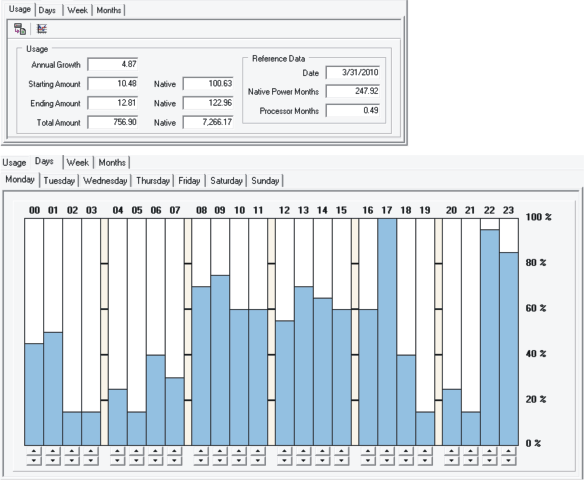Basis for Costing
The foundation for Service
Costing is based on
performance information.
It is this information that
provides the means to
know who is using what in
regards to IT services.
Data Metrics
There are two types of
data metrics that are
needed for Capacity
Planning: Native and
Common. The Native
metrics are those values
that are unique to the
system or platform. The
Common metrics are those
values that are shared by
all processing.
Onboard Intelligence
The means and methods
for Capacity Planning have
been basically forgotten.
While some of it is no
longer needed, the basics
are still required and these
have been incorporated
into RG Solutions®. In
most cases, it has the
knowledge to do the work
for you.
While a program of Capacity Planning is not considered to be relevant today, an effective IT Cost
Transparency program cannot be implemented without one. Service Costing within a Cost
Transparency program is based on two requirements and one of them is to determine the usage
basis of a processing entity (using Capacity Planning methods). RG Solutions® has its roots in
Capacity Management and continues to provide this root capability along with the ability to integrate
performance information with their associated costs. The results identify the usage and “IT Cost of
Service” to the business consumer.
Comprehensive Data
As expected, different applications, systems, and operating systems provide different types of
information. While a lot of this information is similar in nature, there is usually some uniqueness
(native data) based on the source of the data. The sources of information also have a different
means of providing the performance information needed for Capacity Planning.
RG Solutions® understands the different sources used in the collecting of performance
information, and uses a tailored agent to collect the data. The agents are under the control of the
local IT user operations and the resulting data is in the form needed for importing into RG
Solutions®. The different agents collect a full set of performance information at a regular interval
during the course of the day.
Inbuilt Forecasting
The major strength of RG Solutions® for Capacity Planning is its ability to forecast usage levels for
systems and workloads. By using the comprehensive set of performance data collected with the
agent from the actual system, it is possible to create an accurate long term forecast of processing
requirements with generally only one week’s worth of actual data.
The forecasting is done by the user in one of two ways. The first is to provide to RG Solutions®
the annual growth (percent) associated with the processing. The second method is to provide the
starting and ending usage values, and is a forecasting method normally associated with metered
systems. Regardless of the method chosen, RG Solutions® will analyze the underlying patterns of
behavior from the collected performance information and will translate those patterns into an
accurate usage forecast.
Use of Capacity Planning
In the past, Capacity Planning was considered a technical ritual that was regulated to the confines of
the IT staff. As open systems appeared within the marketplace, the perceived need for it went away.
In reality, the need for it was always there but its relevance to the business was never made clear
because IT could never link it to the business.
RG Solutions® has the ability to link traditional Capacity Planning to the business. It has the
ability to identify processing to the workload level and can link this IT processing to the business
consumer that uses it. Once the link is established, the business consumer can then use the
information for business forecasts. These forecasts can be transformed by IT into future workload
forecasts and is necessary for proper capacity planning and provisioning.


